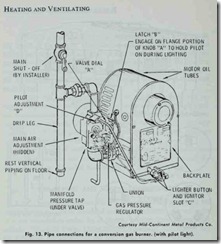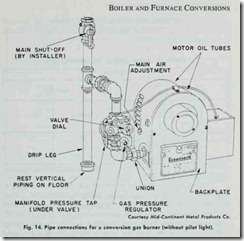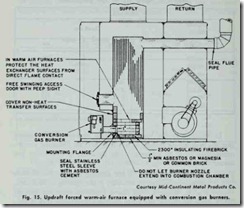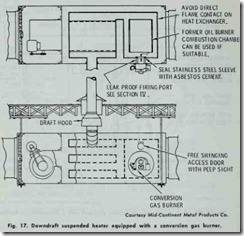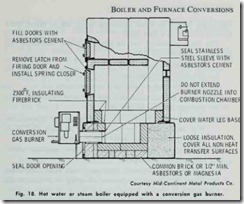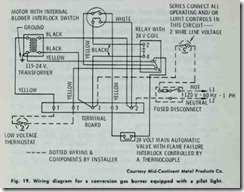STARTING A CONVERSION GAS BURNER (WITH PILOT LIGHT)
This section covers the starting of conversion gas burners equipped with pilot lights. Before attempting to start this type of burner, the piping should be checked for leaks. The basic pro cedure for doing this is as follows:
1. Shut off all other gas appliances (i.e. gas water heaters, etc.) that tie into the same system.
2. Turn on the main shut-off valve (Fig. 13).
3. Turn valve dial “A” to OFF (Fig. 13).
4. Turn on gas pressure to the gas supply line.
5. Watch the meter test dial.
If the meter test dial shows no movement for at least five minutes, it is safe to say that there are no leaks in the piping. Movement of the meter test dial, however, means that you must locate the leak (or leaks) before starting the burner. The soap suds test is a simple and effective method for doing this.
The gas line must be purged before starting the burner. To do this, the following steps are recommended:
1. Disconnect the pilot tubing.
2. Depress valve dial “A” as far as it will go, and turn it counter clockwise to pilot (Fig. 13). Do not release the dial at this point.
3.- With valve dial “A” still fully depressed, lock the dial in position by engaging the lighting latch “B” (Fig. 13).
4. Allow the air to escape until the gas line is completely purged (which will be indicated by gas replacing the air issuing from the pilot connection). Caution: Never purge the gas line into the combustion chamber.
5. Turn off valve dial “A” (depress and turn clockwise).
6. Reconnect the pilot tubing.
After you have checked the piping for leaks and have com pletely purged the gas lines, you are now ready to start the burner. First add a few drops of oil (#20 SAE oil is recommended) to the burner motor bearings. Then, check the setting of valve dial “A”. At this point, it should be turned to OFF (see Step 5 in the purging procedure described above).
You are now ready for the initial start up procedu e which is accomplished as follows:
1. Set the main air shutter at approximately one-quarter open.
2. Turn on the main line switch.
3. Set the room thermostat above room temperature (this will cause the burner motor to start).
4. The burner motor should be allowed to run for about five minutes to insure complete purging of the combus tion chamber.
5. Shut off the burner motor by adjusting the thermostat set ting below room temperature.
6. Fully depress valve dial “A” and tum it counter clockwise to PILOT. Keep it depressed.
7. Lock valve dial “A” in its depressed position by engaging the lighting latch “B”.
8. Light a match and hold the flame under the igniter valve and at ignitor slot “C” while at the same time depressing button “C” for at least 10 seconds.
9. Release the lighter button. The pilot should now ignite.
If it does not, then repeat Step 8 above.
10. After the pilot has been burning for at least one minute, release valve dial “A” and turn it counter clockwise to the ON setting.
STARTING A CONVERSION GAS BURNER (PILOTLESS)
Most of the instructions given in the previous section for starting a conversion gas burner equipped with a pilot light will
also apply here. The major difference is the use of direct spark ignition rather than a pilot flame.
The basic procedure for starting a pilotless conversion gas
burner is as follows (Fig. 14):
1. Check the piping for leaks.
2. Bleed (purge) the gas line.
3. Set the air shutter about three quarters open.
4. Depress the valve dial and turn it to the ON position.
5. Turn on the main line switch.
6. Set the room thermostat above the room temperature.
This should cause the burner motor to start. If it does, burner ignition should occur after 30 seconds.
7. If the burner fails to light, tum off the main line switch and then tum it on again.
8. Readjust the air shutter for a quiet, soft flame. The flame should be blue at the burner, changing to orange at the tips.
9. Start and stop the burner several times with the thermostat to check its operation.
SERVICING A CONVERSION GAS BURNER
Always be sure that the manual gas valve and burner switch are turned off before attempting to service a gas burner. Never attempt to remove any parts for service before taking this precaution.
In direct spark ignition burners, the nozzle and electrode as sembly can usually be removed as a unit. For example, the nozzle and electrode assembly of the Economite Model DS20A conver sion gas burner can be completely removed in the following manner:
1. Remove the burner backplate.
2. Disconnect the pipe union.
3. Remove the curved orifice pipe.
4. Withdraw the nozzle assembly.
5. Disconnect the electrode leads.
6. Remove the unit.
The nozzle and electrode assembly can be reinstalled by re versing Steps 1-6. When reassembling, make certain the orifice pipe enters the nozzle casting.
With the nozzle and electrode assembly completely removed,
you are now in a position to inspect and clean it. Check the electrode for insulator cracks and evidence of serious burning.
Removal of the burner back plate also provides access to the motor and blower, motor relay, low voltage transformer, and terminal board. These can be removed as a unit for servicing, but you will have to disconnect the terminal board and unplug the electrical pass-through fitting to do this. The following service may be required for this unit:
1. Cleaning of the blower wheel.
2. Cleaning the motor air vents.
Does the motor run without further burner sequencing taking place? This may indicate trouble in the centrifugal interlock switch. Some burners are provided with removable motor end caps to provide ready access to the centrifugal switch. If this should be the case, remove the cap and clean the contacts by burnishing. The contacts must be open when the motor is not operating. If necessary, the burner motor can be removed and replaced as follows:
1. Remove the blower wheel.
2. Remove the retainer clips at the motor grommets.
3. Pull the motor out of the brackets.
4. Repair or substitute a new motor.
5. Place motor in brackets.
6. Make certain grommets fit well in the bracket and replace retainer clips.
7. Replace blower wheel.
The sealed motor relay and low voltage transformer normally do not require servicing. They should be replaced when defective.
Check gas lines and valves for leaks with the soap suds test. Never use a flame to locate a gas leak. If the leakage occurs around the valve, the valve seat may need cleaning. Disassemble the valve, clean the seat, and reassemble it. If the valve malfunction is due to causes other than the seat, replace the entire valve.
Replace the gas pressure regulator if it fails to maintain a constant pressure. On the conversion gas burner illustrated in Fig. 14, the regulator is part of a combination valve (in this case a Robertshaw 24-volt combination gas valve), but is designed so that it can be replaced without replacing the entire assembly.
Pressure adjustment required for setting intermediate capaci ties can be accomplished as follows:
1. Remove the adjustment screw cap.
2. Take a screwdriver and turn the adjustment screw counter clockwise to reduce pressure.
3. Measure the pressure through the manometer connection adjacent to the outlet tapping.
Conversion gas burners equipped with a pilot light require in spection and servicing of the following:
1. The pilot orifice size will depend upon the type of gas used.
For the conversion gas burner illustrated in Fig. 13, the pilot orifice will have a diameter of .018 inch for natural gas and .012 inch for propane.
2. Set the end of the burner nozzle at least 1 inch short of the inside of the combustion chamber (see Figs. 15, 16, 17 and 18). It must not be set flush with the chamber or be allowed to extend into the chamber (the pilot is often snuffed out in such cases by recirculated flue products).
3. Check for a high or low gas pressure. If over 7″ w.c., reset the pilot adjustment (see Fig. 13), to reduce the size of the pilot flame and to increase the heat on the thermocouple.
The thermocouple and pilot safety section of the main valve should be tested to determine if they are operating efficiently. The testing procedure is as follows:
1. Turn the burner switch to OFF.
2. Allow the combustion chamber to cool and the pilot light to operate for at least five minutes.
3. Turn off the pilot and listen for a “click” from the main valve.
4. If the “click” of the main valve is heard more than 30 seconds after you have shut off the pilot, then both the thermocouple and the pilot safety section of the main valve are operating efficiently.
5. If the “click” occurs less than 30 seconds after you have shut off the pilot, than either the thermocouple or pilot safety section of the main valve is faulty.
6. Test the thermocouple by disconnecting it from the main valve and checking it with a millivoltmeter. Under normal conditions (i.e. when heated by a standby pilot), it should develop at least 15 millivolts.
7. If the thermocouple develops at least 15 millivolts but the main valve “click” still occurs less than 30 seconds after you have shut off the pilot, the pilot safety section is prob ablymalfunctioning.
8. The thermocouple may also be tested while still connected to the valve (a closed circuit connection) by using an adapter to connect the millivoltmeter. Under normal oper ating conditions, the thermocouple should develop at least 7 millivolts and the valve 4 millivolts.
The wiring diagram for a conversion gas burner equipped with a pilot light is shown in Fig. 19. The installation and service in structions from most manufacturers will include a wiring diagram for the burner. Study it carefully before servicing or making repairs.
